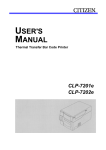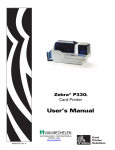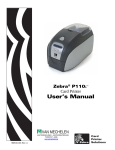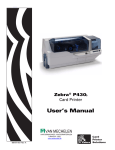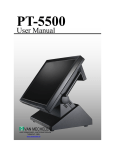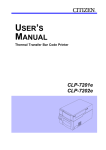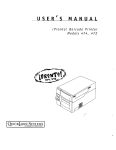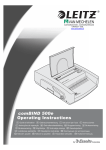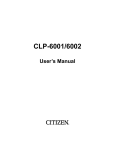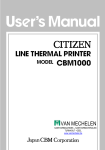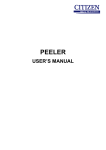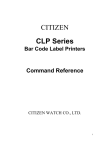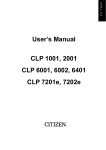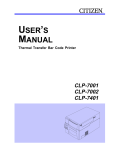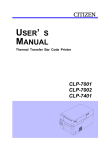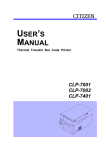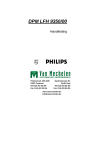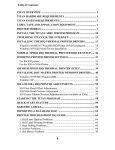Download USER'S MANUAL - Van Mechelen
Transcript
Van mechelen bvba Patersstraat 106-108 2300 turnhout Gasthuisstraat 21 2440 geel Kempen antwerpen noorderkempen limburg 014/41.12.08 014/42.55.99 014/59.26.95 www.vanmechelen.be be0415638961 145.638.961 dexia 068-2221350-77 hrt41.156 kantoormachines – kantoormaterialen kassa weegschaal horeca systemen USER'S MANUAL VLIMMEREN(BEERSE) WECHELDERZANDE ZOERSEL BRECHT MERKSEM LOENHOUT WUSTWEZEL EKEREN(ANTWERPEN) HERENTALS MORKHOVEN NOORDERWIJK PULDERBOS PULLE OLEN OEVEL TONGERLO(ANTW) WESTERLO ZOERLE-PARWIJS HERENTHOUT GIERLE LILLE POEDERLEE WECHELDERZANDE GROBBENDONK VORSELAAR TURNHOUT RIJKEVORSEL HOOGSTRATEN MEER MINDERHOUT WORTEL MEERLE MERKSPLAS BAARLE-HERTOC BEERSE VLIMMEREN VOSSELAAR OUD—TURNHOUT ARENDONK RAVELS WEELDE POPPEL BAARLE-HERTOG MALLE OOSTMALLE WESTMALLE POPPEL(RAVELS) MOL HERENTALS LILLE POEDERLEE(LILLE) HERENTALS(NOORDERWIJK) EINDHOUT LAAKDAL VORST(KEMPEN) LAAKDAL VARENDONK VEERLE GEEL MEERHOUT GIERLE(LILLE) KASTERLEE ICHTAART TIELEN RETIE DESSEL BALEN OLMEN KALMTHOUT BRASSCHAAT HOEVENEN STABROEK BRECHT SINT-JOB-IN-’T-GOOR SINT-LENAERTS HALLE(KEMPEN) HALLE(KEMPEN) ZOERSEL LOENHOUT WUUSTWEZEL OVERPELT NEERPELT SINT-HUIBRECHT-LILLE LOMMEL ACHEL HAMONT HAMONT-ACHEL HECHTEL EKSEL HAM KWAADMECHELEN OOSTHout BOCHOLT KAULILLE REPPEL BEEK BREE GERDINGEN OPITTER TONGERLO(LIMB) LEOPOLDSBURC HEPPEN TESSENDERLO CROTE-BROGEL KLEINE-BROGEL PEER WIJCHMAAL LAAKDAL LAAKDAL Thermal Transfer Bar Code Printer CLP-7201e CLP-7202e VAN MECHELEN KANTOORMACHINES – KANTOORMATERIALEN TURNHOUT –GEEL www.vanmechelen.be Before Operation FCC COMPLIANCE STATEMENT FOR AMERICAN USERS This equipment has been tested and found to comply with the limits for a Class A digital device, pursuant to Part 15 of the FCC Rules. These limits are designed to provide reasonable protection against harmful interference when the equipment is operated in a commercial environment. This equipment generates, uses, and can radiate radio frequency energy and, if not installed and used in accordance with the instruction manual, may cause harmful interference to radio communications. Operation of this equipment in a residential area is likely to cause harmful interference in which case the user will be required to correct the interference at his own expense. COMPLIANCE STATEMENT FOR EUROPEAN USERS 1 Before Operation EMI COMPLIANCE STATEMENT FOR CANADIAN USERS This equipment generates and uses radio frequency energy and if not installed and used properly, that is, in strict accordance with the manufacturer's instructions, may cause interference to radio and television reception. This digital apparatus does not exceed the Class A limits for radio noise emissions from digital apparatus set out in the Radio Interference Regulations of the Canadian Department of Communications. This equipment is designed to provide reasonable protection against such interference in a residential installation. However, there is no guarantee that interference will not occur in a particular installation. If this equipment does cause interference to radio or television reception, which can be determined by turning the equipment off and on, the user is encouraged to try to correct the interference by one or more of the following measures: • Reorient or relocate the receiving antenna. • Increase the separation between the equipment and receiver. • Connect the equipment into an outlet on a circuit different from that to which the receiver is connected. • Consult the dealer or an experienced radio/TV technician for help. CAUTION: Use shielded cables to connect this device to computers. Any changes or modifications not expressly approved by the grantee of this device could void the user's authority to operate the equipment. 2 Before Operation Important Safety Instructions 1. Read all of these instructions and save them for later reference. 2. Follow all warnings and instructions marked on the product. 3. Unplug this product from the wall outlet before cleaning. Do not use liquid or aerosol cleaners. Use a damp cloth for cleaning. 4. Do not use this product near water. 5. Do not place this product on an unstable cart, stand or table. The product may fall, causing serious damage to the product. 6. Slots and openings on the cabinet and the back or bottom are provided for ventilation. To ensure reliable operation of the product and to protect it from overheating, do not block or cover these openings. The openings should never be blocked by placing the product on a bed, sofa, rug or other similar surface. This product should never be placed near or over a radiator or heat register. This product should not be placed in a built-in installation unless proper ventilation is provided. 7. This product should be operated from the type of power source indicated on the marking label. If you are not sure of the type of power available, consult your dealer or local power company. 8. This product is equipped with a three-pronged plug, a plug having a third (grounding) pin. This plug will only fit into a grounding-type power outlet. This is a safety feature. If you are unable to insert the plug into the outlet, contact your electrician to replace your obsolete outlet. Do not defeat the safety purpose of the grounding-type plug. 9. Do not allow anything to rest on the power cord. Do not locate this product where the cord will be walked on. 10. If an extension cord is used with this product, make sure that the total of the ampere ratings on the products plugged into the extension cord do not exceed the extension cord ampere rating. Also, make sure that the total of all products plugged into the wall outlet does not exceed 15 amperes for 120V outlet and 7.5 amperes for 220V(240V outlet. 11. Never push objects of any kind into this product through cabinet slots as they may touch dangerous voltage points or short out parts that could result in a risk of fire or electric shock. Never spill liquid of any kind on the product. 12. Except as explained elsewhere in this manual, don't attempt to service this product yourself. Opening and removing those covers that are marked "Do Not Remove" may expose you to dangerous voltage points or other risks. Refer all servicing on those compartments to service personnel. 13. The mains plug on this equipment must be used to disconnect mains power. Please ensure that the socket outlet is installed near the equipment and shall be easily accessible. 14. Unplug this product from the wall outlet and refer servicing to qualified service personnel under the following conditions: A. When the power cord or plug is damaged or frayed. B. If liquid has been spilled into the product. C. If the product has been exposed to rain or water. D. If the product does not operate normally when the operating instructions are followed. Adjust only those controls that are covered by the operating instructions since improper adjustment of other controls may result in damage and will often require extensive work by a qualified technician to restore the product to normal operation. E. If the product has been dropped or the cabinet has been damaged. F. If the product exhibits a distinct change in performance, indicating a need for service. 3 Before Operation Notice 1. Before use, be sure to read this manual. And keep it handy for reference when needed. 2. The contents of this manual may change without prior notice. 3. Reproduction, transfer, or transmission of the contents of this manual without prior consent is strictly prohibited. 4. We are not liable for any damage resulting from the use of the information contained herein, regardless of errors, omissions, or misprints. 5. We are not liable for any problems resulting from the use of optional products and consumable supplies other than the designated products contained herein. 6. Do not handle, disassemble or repair the parts other than those specified in this manual. 7. We are not liable for any damage caused by user's erroneous use of the printer and inadequate environment. 8. Data residing in the printer is temporary. Therefore, all data will be lost if power is lost. We are not liable for any damage or loss of profits caused by data loss due to failures, repairs, inspections, etc. 9. Please contact us if there are any mistakes or ambiguities within this manual. 10. If there are missing or incorrectly collated pages in this manual, contact us to obtain a new manual. 4 Before Operation 5 Before Operation 6 Before Operation General Precautions 1. Prior to operation, read the safety instructions carefully and observe them. 2. Do not drop or put foreign matter such as clips and pins into the printer. This may cause problems. 3. Be careful when moving or carrying the printer. Dropping the printer may cause injury or property damage. 4. Make sure if you open the top cover, it is opened all the way. If only partially open, the cover could slam shut, possibly causing injury. 5. When the cover is open, be careful of the corners of the cover. They could cause injury. 6. Do not open the printer during printing. 7. When cleaning the surface of the printer case, do not use the cloth that is soaked in thinner, trichloroethylene, benzine, ketone or similar chemicals. 8. Do not use the printer where there is a lot of oil, iron particles, or dust. 9. Do not spill liquids or spray insecticide on the printer. 10. Do not jolt or impact to the printer by stepping on, dropping or hitting the printer. 11. Operate the control panel properly. A careless, rough handling may cause problems or malfunction. Do not use such sharp-edged tool as a ballpoint pen for operation. 12. Be careful of the edges of the plates so injury or property damage is possible. 13. If a problem occurs during printing, stop the printer immediately and unplug the power cord from the outlet. 14. When printer trouble occurs, do not try to dissemble it. Instead, consult our service personnel. 7 Before Operation Precautions When Installing the Printer 1. Prior to operation, read the safety instructions carefully and observe them. 2. Do not use or store the printer near fire, excessive moisture, in direct sunlight, near an air conditioner or heater or other source of unusually high or low temperature or humidity or excessive dust. 3. Do not place the printer where chemical reactions occur, such as in a laboratory. 4. Do not place the printer where air is mixed with salt or gas. 5. The printer must sit on a firm, level surface where there is ample ventilation. Never allow the printer's air vent to be blocked by a wall or other object. 6. Do not put anything on the top of printer. 7. Do not place the printer near a radio or television, and do not use the same wall outlet for the printer and radio or television. Radio or television reception could be adversely affected. 8. Do not use a power voltage or frequency other than those specified. 9. Do not put anything on the power cord or step on it. 10. Do not drag or carry the printer with the power cord or interface cable. 11. Avoid plugging the power cord into an outlet with many loads. 12. Do not bundle the power cord when inserting the plug. 13. Always grip the plug housing, not the cord, to plug/unplug the power cord. 14. Make certain the power is turned off before connecting/disconnecting the interface cable. 15. Avoid lengthening the signal cable or connecting it to any noise-producing device. If it is unavoidable, use the shielded cable or twisted pair for each signal. 16. Place the printer near the outlet where the power cord can be unplugged easily to shut off power. 17. Use the AC outlet that accepts a three-pronged plug. Otherwise, static electricity may be generated and there will be danger of electric shock. 8 Before Operation Contents Before Operation FCC Compliance Statement for American Users----------------------------------------------1 Compliance Statement for European Users ----------------------------------------------------1 EMI Compliance Statement for Canadian Users ----------------------------------------------2 Important Safety Instructions -----------------------------------------------------------------------3 Notice ----------------------------------------------------------------------------------------------------4 Safety Instructions ------------------------------------------------------------------------------------5 Warning --------------------------------------------------------------------------------------------------6 General Precautions----------------------------------------------------------------------------------7 Precautions When Installing the Printer ---------------------------------------------------------8 Contents -------------------------------------------------------------------------------------------------9 Main Features ------------------------------------------------------------------------------------------11 Model Description -------------------------------------------------------------------------------------12 Chapter 1 1 2 3 4 Chapter 2 1 2 3 4 5 6 Setup Confirmation of Carton Contents-----------------------------------------------------------14 Part Names and Functions ------------------------------------------------------------------15 Connection to Power--------------------------------------------------------------------------18 Connection to a Computer-------------------------------------------------------------------19 Printer Operation Power On/Off -----------------------------------------------------------------------------------22 Normal Operating Mode----------------------------------------------------------------------24 Printer Configuration Setting Mode--------------------------------------------------------25 Self-Test Mode & Hex Dump Mode--------------------------------------------------------30 System Maintenance Mode -----------------------------------------------------------------32 Returning to Factory Setting ----------------------------------------------------------------35 9 Before Operation Contents Chapter 3 1 2 3 4 5 6 Media and Ribbon Kinds of Approved Media-------------------------------------------------------------------- 38 Configuration of Approved Media (When Using Front Sensors)------------------- 39 Configuration of Approved Media (When Using Adjustable Sensor)-------------- 40 Media Setting----------------------------------------------------------------------------------- 41 Kinds of Approved Ribbons ----------------------------------------------------------------- 43 Ribbon Setting --------------------------------------------------------------------------------- 44 Chapter 4 Printer Adjustments 1 Use of Media Other Than the Recommended (Printhead Offset Adjustments) ------------------------------------------------------------ 48 2 Use of Narrow Media/Ribbons (Printhead Pressure Adjustments) -------------------------------------------------------- 49 3 Use of Narrow Media/Ribbons (Ribbon Tension Adjustments)--------------------- 50 4 Adjustable Sensor (For CLP-7201e) ----------------------------------------------------- 52 5 Cleaning ----------------------------------------------------------------------------------------- 53 Chapter 5 1 2 3 4 5 6 Troubleshooting Error Messages-------------------------------------------------------------------------------- 56 Power Troubleshooting ---------------------------------------------------------------------- 60 Media Feed troubleshooting ---------------------------------------------------------------- 61 Ribbon Feed Troubleshooting-------------------------------------------------------------- 62 Print Troubleshooting------------------------------------------------------------------------- 63 Interface Troubleshooting ------------------------------------------------------------------- 64 Appendixes 1 Options------------------------------------------------------------------------------------------- 66 2 Specifications----------------------------------------------------------------------------------- 68 10 Before Operation Main Features Optimum ribbon tension The Active Ribbon Control & Positioning technology used in this printer gives improved print quality with a wide range of media and ribbon combinations. ARCP is designed to eliminate ribbon wrinkling and slippage. Thus print registration and positioning especially with small labels are improved. When a ribbon is initially installed, the source ribbon spool is considerably larger than the destination spool. By the end of the ribbon, this situation is reversed leading to noticeable variations in ribbon tension. Our new ARCP technology is designed specifically to eliminate this effect by equalizing the ribbon tension throughout the print run. High-speed, high-quality printing This printer adopts both a direct-thermal and thermal-transfer printing system with the line thermal head and its unique control IC enables high-speed and high-quality printing. Powerful control language A powerful yet simple to use control language is standard to all of Citizen's label printers allowing easy design of labels and bar codes. Alternatively, Citizen provides printer drivers for popular operating systems such as Windows(tm). Easy operation Thanks to the clam-shell mechanism, labels, media and ribbons are loaded easily and maintenance such as head cleaning is carried out smoothly. IEEE1284 Parallel, serial and USB ports as the standard The enhanced parallel, serial and USB ports are provided as the standard to enable high-speed data transmitting and industry compatible connectivity. Adjustable sensor The adjustable, moveable sensor, standard on the CLP-7201e, allows irregularly cut labels and tags to be used with ease. The sensor can also detect black registration marks that are not at the edge of the media. LAN Ethernet and WiFi (optional) The LAN Ethernet and WiFi interfaces are optionally available to meet the variety of needs of computer-printer network. Trademark Acknowledgement: Windows: Microsoft Corporation 11 Before Operation Model Description The following two models are available. The main different points between the two models are shown below. Model Print resolution Printing speed Adjustable media sensor Flash Memory CLP-7201e 200dpi 2−7 IPS Standard Standard on-board CLP-7202e 200dpi 2−7 IPS Optional Via PCMCIA card 12 Chapter 1 Chapter 1 Setup 1 Confirmation of Carton Contents 2 Part Names and Functions 3 Connection to Power 4 Connection to a Computer 13 Setup Chapter 1 1 Setup Confirmation of Carton Contents 1 Confirmation of Carton Contents Check that the following accessories are included with the printer in the carton. The empty carton and packing materials should be stored for future shipping of the printer. CAUTION • Be careful when moving or carrying the printer and when taking the printer out of the carton. The printer may cause injury or property damage if dropped. Be sure to grip the printer housing firmly when taking it out of the carton. Do not grip the printer by the foam packing material which may break, causing the printer to drop. • When opening the cover, open it all the way. If only part way open, the cover could slam shut, possibly causing injury. • Be careful of the edge of the cover when the cover is opened. It may cause injury or property damage. • Be careful of the edges of the metal plates so injury or property damage is possible. 14 Chapter 1 2 Setup Part Names and Functions 2 Part Names and Functions Front view (8) Open lever To swing the printhead out of the way when loading the media or cleaning the printhead. (See Chapter 3.) (1) Cover Opens to allow loading of the media and ribbon. (2) Control panel To set the printer configuration settings. (See Chapter 2.) (9) Printhead pressure adjustment knob (See Chapter 4.) (10) Open guide Holds down the media. The adjustable, movable media sensor inside (available for the model CLP-7201e) detects the media position. (See Chapter 3.) (3) Ribbon holder To attach the ribbon. (See Chapter 3.) (4) Ribbon winder To wind the ribbon after printing. (See Chapter 3.) (5) Roll holder Holds the roll of media. (11) Open guide lever Pressing this opens the open guide to replace the media. (See Chapter 3.) (6) Roll guide Guides the roll of media. This is adjusted according to the width of the media. (See Chapter 3.) (12) Front sensors Detect the label or tag position. (See Chapter 3.) (7) Media holder Holds the roll holder. (See Chapter 3.) (13) Offset check window Allows you to check the optimum position of the printhead. (See Chapter 4.) 15 Chapter 1 2 Setup Part Names and Functions Side view (1) Adjust-screw To change the ribbon tension setting on the winding side. (See Chapter 4.) (2) Rear tension knob To change the ribbon tension setting on the feeding side. (See Chapter 4.) Rear view (1) Serial interface connector To connect the serial interface cable. (2) USB interface connector To connect the USB interface cable. (3) Parallel interface connector To connect the parallel interface cable. (4) Power switch To turn on or off the power. (See Chapter 2.) (5) Power inlet To connect the power cord. (6) PCMCIA memory card cover To protect the PCMCIA memory card from exposure to dust and foreign matter. To install a PCMCIA memory card, first unhook this cover, then slide it out. (See Appendixes.) 16 Chapter 1 2 Part Names and Functions Control panel (5) STOP key Stops the printer operating. (1) LCD Displays the current printer status, configuration settings, or an error message. (2) LEDs One LED is the power indicator and the other the error indicator. (3) PAUSE key Temporarily pauses printing. (6) Media gap adjustment control To adjust the media gap sensor sensitivity. (7) Black mark adjustment control To adjust the black mark sensor sensitivity. (8) LCD contrast adjustment control To adjust the LCD contrast. (4) FEED key Feeds the media. 17 Setup Chapter 1 3 Setup Connection to Power 3 Connection to Power 1. Check that the power switch to the printer is turned OFF. 2. Connect the connector of the power cord to the power inlet on the printer. 3. Insert the plug of the power cord in the AC outlet. CAUTION • Use an AC outlet that accepts a three-pronged plug. Otherwise, static electricity may be generated and there will be danger of electric shock. 18 Chapter 1 4 Connection to a Computer 4 Connection to a Computer An interface cable is necessary to connect the printer to a computer. To connect the cable, proceed as follows: 1. Turn OFF both power switches of the printer and the computer. 2. Connect the connector of one end of the interface cable to the interface connector on the back of the printer and secure it with locks or locking screws. 3. Connect the connector of the other end of the interface cable to the interface connector on the computer and secure it with locks or locking screws. 19 Setup Chapter 1 Setup 20 Chapter 2 Chapter 2 Printer Operation 1 Power On/Off 2 Normal Operating Mode 3 Printer Configuration Setting Mode 4 Self-Test Mode & Hex Dump Mode 5 System Maintenance Mode 6 Returning to Factory Setting 21 Printer Operation Chapter 2 1 Printer Operation Power On/Off 1 Power On/Off Turning on the power 1. Turn on the power switch on the back of the printer. 2. The green LED is lit. Check that the LCD screen displays 'On Line.' 22 Chapter 2 Printer Operation 1 Turning off the power 1. Turn off the power switch on the back of the printer. 2. The green LED goes off and any message on the LCD screen disappears. 23 Power On/Off Chapter 2 2 Printer Operation Normal Operating Mode 2 Normal Operating Mode When the power is turned on, the printer enters the normal operating mode, which allows normal printing. The control key functions are as follows: STOP key With this key, the operator can stop and cancel the current print job. Pressing the STOP key during printing stops the printing immediately. Pressing it again cancels the print job. FEED key Advance to the top of the next label. When Using continuous media, make sure the Sensor selection is set to ContinuP or a Media error will result. PAUSE key Temporarily pauses printing. 'Pause' is displayed on the LCD screen. If pressed during printing, printing will stop after the current label is printed. Press the PAUSE key again to resume printing. 24 Chapter 2 3 Printer Operation Printer Configuration Setting Mode 3 Printer Configuration Setting Mode In this menu, the print mode, the 'after printing function' such as cutting or peeling, media sensor selection and print quality settings such as print speed or density are configured. Control key functions are shown below. The printer configuration settings are stored in memory so they are maintained even after the power is turned off. Example: Changing the media gap sensor to the black mark sensor 1. First check the printer goes On Line, then press and hold down the PAUSE key and press the FEED key. 2. Change the print mode (direct-thermal or thermal transfer printing) to the sensor selection with the PAUSE key. 25 Chapter 2 3 Printer Operation Printer Configuration Setting Mode 3. Change the media gap sensor to the black mark sensor with the FEED key. 4. Return to normal operating mode with the STOP key. 26 Chapter 2 3 Display Indications 27 Printer Operation Printer Configuration Setting Mode Chapter 2 3 Printer Operation Printer Configuration Setting Mode List of Mode Items Note: When the printer is switched off and on, the initial values for these menu items selected by the printer configuration setting mode will be retrieved from the flash memory. 28 Chapter 2 3 Printer Operation Printer Configuration Setting Mode Notes when setting print start position and media stop position • When the "AfterPnt" menu item is set to "AutoCut", the relation between print start position and media stop position should be set to [(O ( (f]. If the value is set so that [(O < (f], the media may be out of platen. • If the absolute value to O value is larger than the absolute value to f value as the set value of [(O] increases, the media stop position may change. However, if the absolute value to f value is smaller than the absolute value to O value as the set value of [(f] decreases, the media stop position may not change. • When the "AfterPnt" menu item is set to "PeelWait", the set value of [(f] should be limited; the larger value causes labels to unexpectedly peel off. 29 Chapter 2 4 Printer Operation Self-Test Mode & Hex Dump Mode 4 Self-Test Mode & Hex Dump Mode In this mode, self-test printing is performed, and you can check the current printer configuration settings and print quality. After loading the media and ribbon, operate the printer in the following way: 1. Turn ON the power switch while pressing and holding the FEED key. When labels are used, hold down the FEED key for two seconds and the printer will feed the media and print samples 1 and 2 (see below) and stop. When continuous media is used, hold down the FEED key for four seconds and the printer will feed the media and print samples 1 and 2 (see below) and stop. 30 Chapter 2 4 Printer Operation Self-Test Mode & Hex Dump Mode Check the following items in the self-test mode. Check item Cause Remedy Dot missing Printhead disconnected Replace printhead Dust adhered Clean printhead (see Section 5, Chapter 4) Printhead offset changed in position Adjust printhead offset (see Section 1, Chapter 4) Printing energy low Adjust printing energy (see Command Reference) Partially blurred Printhead pressure unbalanced Adjust printhead pressure (see Section 2, Chapter 4) Ribbon wrinkling and slipping Ribbon tension improper Adjust ribbon tension (see Section 3, Chapter 4) Totally blurred 2. After self-test printing, the printer enters the data dump mode (hex dump mode). The contents of communication can be checked with the communication data printed in ASCII code. 3. Return to normal operating mode after turning OFF the power switch and turning ON again. 31 Chapter 2 5 Printer Operation System Maintenance Mode 5 System Maintenance Mode In system maintenance mode, the communication, adjustable sensor ON/OFF and sensor voltage selections are set up. The printer configuration settings are stored in memory so they are maintained even after the power is turned off. Control key functions are shown in the following: Example: Setting the black mark sensor voltage 1. First turn OFF the power switch, then press and hold the PAUSE, FEED and STOP keys simultaneously and at the same time turn ON the power switch. 2. Change the baud rate to the sensor voltage setting with the PAUSE key pressed. 32 Chapter 2 5 Printer Operation System Maintenance Mode 3. Change the media gap sensor voltage to the black mark sensor voltage with the FEED key pressed. 4. Return to normal operating mode with the STOP key pressed. 33 Chapter 2 5 Printer Operation System Maintenance Mode List of Mode Items Note: When the printer is switched off and on, the initial values for these menu items selected by the system maintenance mode will be retrieved from the flash memory. 34 Chapter 2 6 Printer Operation Returning to Factory Setting 6 Returning to Factory Setting To return all the contents already made in the printer configuration setting mode or system maintenance mode to the factory setting, proceed as follows: First turn OFF the power switch, then press and hold the PAUSE, FEED and STOP keys simultaneously and at the same time turn ON the power switch, and continue holding down those keys. Factory setting 35 Chapter 2 Printer Operation 36 Chapter 3 Chapter 3 Media and Ribbon 1 Kinds of Approved Media 2 Configuration of Approved Media (When Using Front Sensors) 3 Configuration of Approved Media (When Using Adjustable Sensor) 4 Media Setting 5 Kinds of Approved Ribbons 6 Ribbon Setting 37 Media and Ribbon Chapter 3 1 Media and Ribbon Kinds of Approved Media 1 Kinds of Approved Media 38 Chapter 3 2 Media and Ribbon Configuration of Approved Media (When Using Front Sensors) 2 Configuration of Approved Media (When Using Front Sensors) The front sensors consist of the transparent and reflective type photosensors that detect the position of the labels or tags: Transparent type photosensor: Detects gaps between labels and notches of tags. Reflective type photosensor: Detects black marks. Note: Make sure that the adjustable sensor is set to 'AJSensOF.' (See Chapter 2.) • Dimensions of media For gaps between labels, notches of tags (labels) and black marks, see the size of media below. 39 Chapter 3 3 Media and Ribbon Configuration of Approved Media (When Using Adjustable Sensor) 3 Configuration of Approved Media (When Using Adjustable Sensor) The adjustable sensor is the standard for CLP-7201e but it is the optional for CLP-7202e. Make sure that the adjustable sensor is set to 'AJSensON.' (See Chapter 2.) 40 Chapter 3 Media and Ribbon 4 Media Setting 4 Media Setting The printer is designed to easily load media. Open the printer cover and set media in the following: 1. Push down the open lever to open the printhead. 2. Push down the open guide lever to lift the open guide up. 3. Insert the roll holder with the roll guide in the core of roll media. Load this onto the media holder and push against the left side wall and secure roll media. CAUTION Be careful of the edges of the plates so injury or property damage is possible. 41 Chapter 3 4 Media and Ribbon Media Setting 4. (1) Push media against the fixed media guide on the left side. (2) Guide media positively with the movable media guide. (3) Align the left top edge of media with the notch of the tearing plate. 5. Holding media so as to ensure it cannot skew, push down the open guide to close it. 6. Push down the green part of the push button to close the printer mechanism; at this time, continue pushing until it clicks closed. Note: Make sure the green part of the push button is pressed properly. Otherwise, the printer mechanism may fail to close. 7. Close the printer cover. 8. Turn ON the power switch of the printer. The LCD screen on the control panel will show 'On Line.' Then press the FEED key and media will advance to the next label position and stop. 42 Chapter 3 5 5 Kinds of Approved Ribbons 43 Media and Ribbon Kinds of Approved Ribbons Chapter 3 6 Media and Ribbon Ribbon Setting 6 Ribbon Setting This printer is designed for easy ribbon loading. Open the printer cover and install the ribbon as follows: 1. Push down the open lever to open the printhead. 2. Insert the ribbon shaft in the core of ribbon so that it is in its deepest position. 3. Set the ribbon holder on the transfer mechanism. 4. Pull the ribbon from under the transfer mechanism to the ribbon winding side. CAUTION Be careful of the edges of the plates so injury or property damage is possible. 44 Chapter 3 Media and Ribbon 6 Ribbon Setting 5. Wind the ribbon being pulled out around the ribbon holder and fix it to the core with adhesive tape. Set the ribbon holder on the transfer mechanism. Then turn its knob in the direction of arrow to remove the slack or wrinkle of the ribbon. Also any slack or wrinkle of the ribbon must be removed from the bottom of the transfer mechanism. 6. Push down the green part of the push button to close the printer mechanism until it clicks. CAUTION Make sure the green part of the push button is pressed properly. Otherwise, the printer mechanism may fail to close. 7. Close the printer cover. 8. Turn ON the power switch of the printer. The LCD screen on the control panel will show 'On Line.' Then press the FEED key and media will advance to the next label position and stop. 45 Chapter 3 Media and Ribbon 46 Chapter 4 Chapter 4 Printer Adjustments 1 Use of Media Other Than the Recommended (Printhead Offset Adjustments - Media Thickness Adjustments) 2 Use of Narrow Media/Ribbons (Printhead Pressure Adjustments) 3 Use of Narrow Media/Ribbons (Ribbon Tension Adjustments) 4 Adjustable Sensor (For CLP-7201e) 5 Cleaning 47 Printer Adjustments Chapter 4 1 Printer Adjustments Use of Media Other Than the Recommended (Printhead Offset Adjustments - Media Thickness Adjustments) 1 Use of Media Other Than the Recommended (Printhead Offset Adjustments - Media Thickness Adjustments) The printer is already factory-set to the requirements of proper print quality while using the recommended labels. If the print quality is inferior because of the different type of media, adjust the printhead offset in the following manner: (a) When using standard labels, or thermal media (1) Looking in at the offset check window, reset the printhead offset so that it comes to the center line (middle of the three lines) by turning the offset adjustment screw with a screwdriver. Then turn the offset adjustment screw two to four times counterclockwise with a screwdriver. (Factory setting: two turns.) (2) Make fine adjustments by checking the self-test print. (b) When using thick media (tags or other media) (1) Looking in at the offset check window, reset the printhead offset so that it comes to the center line (middle of the three lines) by turning the offset adjustment screw with a screwdriver. (2) Then turn the offset adjustment screw two to four times clockwise with a screwdriver. (3) Make fine adjustments by checking the self-test print. 48 Chapter 4 2 Printer Adjustments Use of Narrow Media/Ribbons (Printhead Pressure Adjustments) 2 Use of Narrow Media/Ribbons (Printhead Pressure Adjustments) The printer is already factory-set to the value of media width: 112 mm (4.4 in). When you use narrow media, adjust the printhead pressure in the following: 1. Looking in at the check window on the upper frame, align the mark (the left end of white plastic) with the width of media by turning the printhead pressure adjustment knob. (The printhead must be closed.) 2. Make fine adjustments by checking the self-test print. (a) When the print on right side is too light: Move the mark (white) to the right side by turning the printhead pressure adjustment knob clockwise. (b) When the print on the left side is too light: Move the mark to the left side by turning the printhead pressure adjustment knob counterclockwise. 49 Chapter 4 3 Printer Adjustments Use of Narrow Media/Ribbons (Ribbon Tension Adjustments) 3 Use of Narrow Media/Ribbons (Ribbon Tension Adjustments) Ribbon tension of this printer is already adjusted to the recommended ink ribbon and media. Ribbon and media, however, may slip due to imperfect combination of ink ribbon and media, where a message 'RibonOut' will be shown on the LCD display. To resolve this problem and obtain the optimum printing condition, make adjustments in the following manner (this should be done after the printhead pressure adjustments on the previous page are made): 1. Adjusting Places 2. Adjusting Method (1) General ribbon and media Factory setting: both marks on winding and feeding sections are set to STANDARD so as to obtain the optimum printing condition for the recommended ink ribbon and media. 50 Chapter 4 3 (2) Easy-to-slip ribbon and media If a message 'RibonOut' is shown, set the mark on the feeding section to LOW by turning the adjust-knob. (3) Especially-easy-to-slip ribbon and media If a message 'RibonOut' is still shown, although Step (2) has been performed, set the mark on the feeding section to SUPER LOW by turning the adjust-knob. (4) When ribbon is broken during printing Ribbon may be broken if it is narrow in width and printhead heat temperature is high. In that case, set the mark on the feeding section to SUPER LOW and set the mark on the winding section to LOW by turning the adjust-knob and adjust-screw respectively. Note: If the problem is still not resolved, please contact our service personnel. 51 Printer Adjustments Use of Narrow Media/Ribbons (Ribbon Tension Adjustments) Chapter 4 4 Printer Adjustments Adjustable Sensor (For CLP-7201e) 4 Adjustable Sensor (For CLP-7201e) Note: The adjustable sensor is optional for CLP-7202e. Operating procedure 1. Measure your required detection position beforehand, using the scale on the upper guide rail. Move the adjustable sensor to the required detection position by tuning the adjustable knob; it is useful to align the mark (yellow) on the top of the adjustable sensor with the scale showing the required detection position. For the movable range of the adjustable sensor, see figure below. 2. Set media with liner. Then close the upper guide rail and set the voltage to 3V. Note: For voltage setting, see Section 5 System Maintenance Mode, Chapter 2. 52 Chapter 4 Printer Adjustments 5 Cleaning 5 Cleaning Wipe off any foreign matter such as ribbon or media dust, dirt and adhesive substances built up around the printhead, ribbon guide roller, platen etc with the accessory thermal head cleaner or a soft cloth soaked in ethyl alcohol. It is particularly important to clean the printhead after printing on thermal media for long periods, which will guarantee the print quality and extend the life of the printhead. Note: Always use the thermal head cleaner when cleaning the printhead. CAUTION Do not use any solvent other than ethyl alcohol. Solvents such as benzene, acetone and thinner will dissolve plastic parts and destroy the printhead, platen and much of the printer! 53 Chapter 4 Printer Adjustments 54 Chapter 5 Chapter 5 Troubleshooting 1 Error Messages 2 Power Troubleshooting 3 Media Feed Troubleshooting 4 Ribbon Feed Troubleshooting 5 Print Troubleshooting 6 Interface Troubleshooting 55 Troubleshooting Chapter 5 1 Troubleshooting Error Messages 1 Error Messages When there is a problem with the printer: - A buzzer sounds. - The error indicator lights up. - An error message is shown on the LCD screen. Errors and corrective actions are shown below. 1 Errors indications 56 Chapter 5 1 2 Errors and corrective actions 57 Troubleshooting Error Messages Chapter 5 1 Troubleshooting Error Messages 58 59 Chapter 5 Troubleshooting 1 Error Messages Chapter 5 2 Troubleshooting Power Troubleshooting 2 Power Troubleshooting 60 Chapter 5 3 3 Media Feed Troubleshooting 61 Troubleshooting Media Feed Troubleshooting Chapter 5 4 Troubleshooting Ribbon Feed Troubleshooting 4 Ribbon Feed Troubleshooting 62 Chapter 5 5 5 Print Troubleshooting 63 Troubleshooting Print Troubleshooting Chapter 5 6 Troubleshooting Interface Troubleshooting 6 Interface Troubleshooting 64 Appendixes Appendixes 1 Options 2 Specifications 65 Appendixes 1 Options 1 Options z Factory and dealer (reseller) options 66 Appendixes 1 Options z User options Note: Some versions of this printer have flash memory installed on the main PCB as standard. You may not need to use a PCMCIA card in this case. Please contact the dealer from where you purchased the printer for further details. Installation 1. Turn OFF the power switch of the printer. 2. Remove the PCMCIA memory card cover at the bottom of the printer (see figure). 3. Insert the memory card. 4. Replace the PCMCIA memory card cover. CAUTION • Before use, carefully read and understand the instructions regarding the PCMCIA memory card. • Do not insert or remove the PCACIA memory card before the power to the printer is turned off. • Always close the PCMCIA memory card cover to keep out foreign matter such as particles of dust. • If the PCMCIA memory card write failure occurs, check it with the test command (STX.w). 67 Appendixes 2 Specifications 2 Specifications z Main Specifications 68 Appendixes 2 69 Specifications Appendixes 2 Specifications 70 Appendixes 2 Specifications z Interfaces The printer is connected to a computer and prints labels according to the command from the computer. Two systems of interface connection to a computer are shown below. 1. Serial interface: RS-232C 2. Parallel interface: IEEE1284 compatible and nibble modes 71 Appendixes 2 Specifications 3. USB Interface USB Interface Specifications USB1.1 4. RS-232C loopback test After connector wiring as shown in the figure, place the printer into self-test mode. The printer will receive data that has been transmitted by printer itself and the test of receiving and transmitting data will be performed. 72 Appendixes 2 Specifications 5. RS-232C protocol (1) X-ON/X-OFF system (see figure) This is a control system in which the data transmitting request signal (X-ON (11H) code) and the data transmitting stop signal (X-OFF (13H) code) are output. Requirements of output of X-ON code: • When the power is switched to ON. • When the receive buffer has less than 2K bytes available, the X-OFF code is output, and the receive buffer has at least 4K bytes available. Requirements of output of X-OFF code: • When the receive buffer has less than 2K bytes available. Note: Even if each code is ready for output, the same code will not be transmitted twice successively (except when the power is turned on or the printer is reset from the control panel). (2) Ready/Busy system (see figure) This is a control system in which the DTR is output at Ready (High) or Busy (Low) level. The DTR, however, is always output at Ready (High) level except the following: Requirements of output of DTR 'Low': • When the receive buffer has less than 2K bytes available. When this condition is detected, the printer keeps a 'Low' level until the receive buffer has at least 4K bytes available. 73 Appendixes 2 Specifications 6. Interface pin assignment The serial and parallel pin assignment tables are shown below. Serial interface pin assignment table 74 Appendixes 2 Parallel interface pin assignment table 75 Specifications Appendixes 2 Specifications z Example of Connection to a Computer When RS-232C is used: (IBM PC compatible) Communication control: XON/XOFF or CTS/DTR 76 Appendixes 2 Specifications z Tear-Off Function The tear-off function eliminates the waste of labels when tearing manually. It allows media to automatically advance to the tear position after printing. When this function is turned on, media will be fed to the manual tear position after printing. The printer will feed back media to the start print position when the next print job is sent. If data is transmitted continuously from the computer, the tear-off function will be suppressed to increase throughput. 1. Turning Tear ON/OFF Tear can be turned to ON or OFF from the control panel. Default is OFF. Indications on the control panel are as follows LCD screen Tear-off invalid Tear-off valid 'NoAction' 'TearBar' 77 Appendixes 2 Specifications 2. Tear-off when printing • If set, the tear-off feature will start if no data is transmitted from the computer after printing. If data is transmitted continuously from the computer, the tear-off function will be suppressed. Tear-off is only performed for the final label of each batch processing. (The tear-off is not performed until the specified number of print sheets is completed.) • Media is fed to the tear position • When manual tearing is needed, tear the label at this time. • Performs next label printing. When next print data is transmitted form the computer, the printer feeds back media to the previous print completed position and resumes printing. 78 Appendixes 2 Specifications 3. Tear-off when feeding • Media are fed to the tear position. • When the manual tearing is needed, tear the label at this time. • Perform next feeding or label printing. If the Feed key is pressed or next print data is transmitted from the computer, the printer will feed back media to the previous print completed position and resume feeding or printing. 79 Appendixes 2 Specifications z Cut Position Adjustments • The cut position can be specified with the 'fnnn' of the system-level commands. When the tear-off function is turned on, the following initialization value is set in the printer. Initialization value: fnnn = f735 (73.5 mm) The values higher or lower will increase or decrease the amount of feed in the tear-off. • Parameter initialization values Initialization values of print and feed positions by each operating mode are described below. If values lower than the minimum values are set, the initialization values will be set instead. (When the virtual distance between the print and feed positions' mode is on.) 80 Citizen America Corporation 831 S. Douglas Street, Suite 121 El Segundo, CA 90245 Tel: (310) 643-9825 U.S.A. Citizen Systems Europe GmbH http://www.citizen-europe.com Mettinger Strasse 11 Park House 73728 Esslingen 643-651 Staines Road, Feltham Germany Middlesex, TW14 8PA United Kingdom Japan CBM Corporation CBM Bldg., 5-68-10, Nakano Nakano-ku, Tokyo 164-0001 Tel: (+81-3) 5345-7540 Fax:(+81-3) 5345-7541 Japan JE99716-02 (70904032) Printed in Japan


















































































